Home » Athena Symbol Guide: Complete List of All Her Symbols
Athena Symbol Guide: Complete List of All Her Symbols
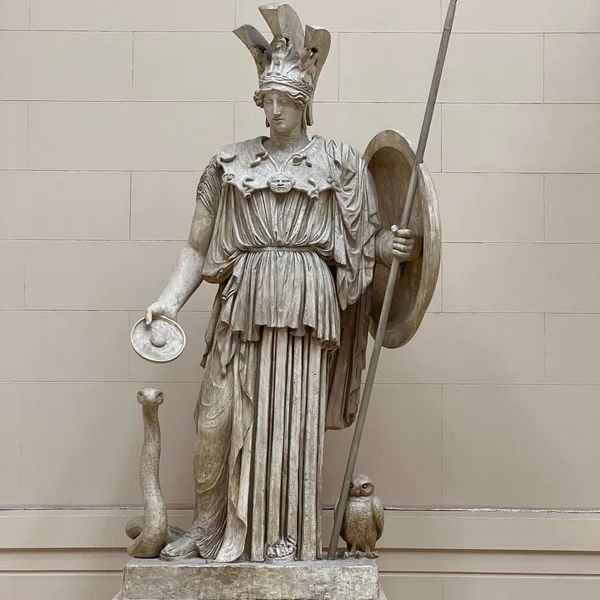
Each Athena symbol represents some aspect of her life and her duties as a divine figure in the ancient world.
There are quite a few objects connected to the Greek Goddess that make her one of the most memorable deities of all time. This guide reveals all Athena symbols and the reasons why she is associated with them.
Seeing all the objects connected to her gives you a better understanding of what type of Goddess she was and the symbolism that defines her legendary status in Greek mythology.
From the most popular symbol of Athena like the owl, all the way to the much lesser known objects like the chariot and the snake, this guide breaks it all down in a quick and simple format.
Let’s begin…
Every Athena Symbol Explained
List of Athena’s symbols and their meaning…
1. Owl
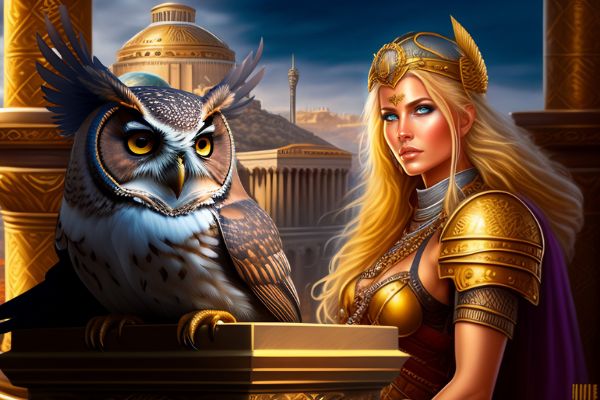
She’s associated with many objects.
But there are 2 that stand out from the rest.
The owl and the olive tree.
In Greek mythology, the owl was chosen as a symbol of Goddess Athena because it was a bird often associated with wisdom and knowledge. The Goddess was known for her intelligence and her ability to solve problems, so the owl was a fitting representation of her.
In art and literature, she was often depicted with the owl, either perched on her shoulder or perched nearby. This association between the Goddess and the owl has endured throughout the ages and it became Athena’s sacred animal symbol.
It’s also associated with her other positive qualities, such as strength and justice.
The owl represents her role as a source of knowledge and guidance in the Greek pantheon.
And it’s one of the most well-known objects connected to her.
2. Olive Tree
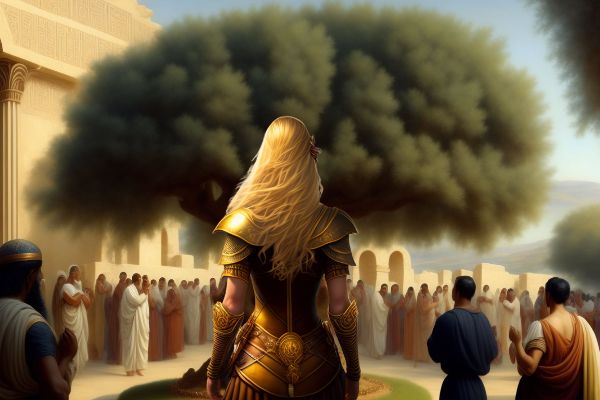
The olive tree, on the other hand, became one of Athena’s symbols because she is said to have created it on the spot when she competed against Poseidon in their clash for Athens.
According to the story, they had a contest to see who would become the patron god or goddess of Athens.
She won the contest by creating an olive tree from nothing.
All the women of Athens considered the olive tree to be more important than what Poseidon created, as it could provide food and oil, so they voted for her.
That’s how she became the patron goddess of Athens, and how the olive tree came to represent her.
The olive tree also came to be a sign of peace.
It’s where the expression “extending an olive branch” came from.
The tree was also used in religious ceremonies.
The owl and the olive tree are Athena’s most famous symbols.
3. Spear

Armor has long been associated with the Greek goddess, and has come to symbolize her role as a warrior, protector, and craftsman.
In her role as the Goddess of War, she was often depicted wearing armor as a sign of her strength and bravery in battle.
The spear is one of the more recognizable symbols that represent Athena and that people still connect her with.
Since she is the Greek Goddess of warfare, she is associated with a number of different types of armor.
In ancient Greece, warriors used spears as their primary weapon, and so it makes sense that she would be associated with this weapon.
The spear is not only a sign of Athena’s power, but it also represents the fact that she is an independent goddess that could fend for herself.
In ancient mythology, she is described as using her spear to defend her city, Athens, from invaders. In some stories, the goddess is even said to have created the first spear known to humans.
Though not as widely recognized as the owl, the spear is an important part of her mythology and serves as a reminder of her strength.
4. Shield
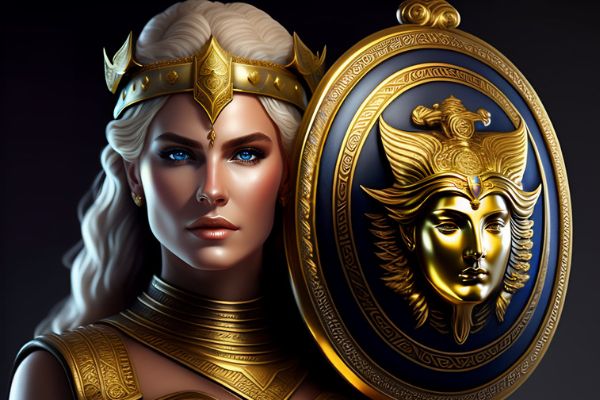
Throughout history, the aegis (or shield) has been a powerful and enduring sign of Athena’s role as a protector and defender. It has inspired artists and writers to depict the Goddess with the aegis in their works, and it has become a lasting Athena symbol even till this day.
Her aegis is typically depicted as a shield or breastplate with a border of snakes and the head of the Gorgon Medusa in the center. The Gorgon Medusa was a monster with snakes for hair and the ability to turn those who looked upon her to stone.
The presence of the Gorgon’s head on the aegis is said to imbue the shield with the power to protect the Goddess Athena and her allies, as well as to strike fear into her enemies.
The aegis is associated with war and protection. And since she was the goddess of war, it’s easy to see why she’s connected to this particular object.
Regardless of the reason for the association, it is clear that the aegis has been linked to her for a long time.
5. Weaving
She was a patron of the arts. So for many people, arts and crafts became a symbol of Athena and what she represented.
Especially the artistry of weaving.
In many cultures, weaving was a revered art form, and those who could weave were highly respected. This was especially true in ancient Greece.
Weaving was one of the main forms of art.
It not only helped create clothing, blankets, and other textiles that were essential for everyday life, but the finished product was often beautiful as well as functional.
It was a way to express creativity and artistry. The weavers of ancient Greece used different techniques and patterns to create beautiful crafts.
Many times, the finished product was often judged by others for how beautiful and artful it was, or wasn’t.
The art of weaving became a symbol of Athena’s intelligence, creativity, and skills as a craftsman, and it continues to be associated with her to this day.
The main reason for her connection to weaving arises from the story of her contest with Arachne, in which she challenges Arachne to a weaving contest.
The Goddess was known for her wisdom and her ability to think creatively, and these qualities were often represented by her association with the art of weaving.
6. Helmet
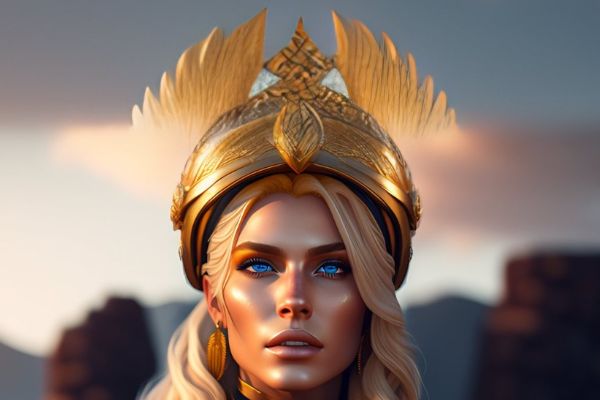
Another one of the reasons she is linked to war is because she is frequently shown wearing a battle helmet.
There are several explanations why the helmet is a symbol of Athena.
Helmets are an important part of armor that protect the head, which is a vulnerable area in combat. Secondly, the helmet can be seen as a sign of authority and power, both of which the goddess commanded.
In some stories, it is said that the helmet was given to her by her father Zeus, and that it made her invincible in battle.
Essentially, Athena’s helmet represents the ideal characteristics of a good soldier.
This type of armor played an important role in her legend, especially in artwork. The helmet not only signifies Athena’s power, but it also represents her ability to protect those who are fighting for justice.
7. Snake or Serpent
Athena had some interesting animal symbols associated with her.
Besides the owl, she was also represented by a serpent or snake.
The snake was seen as a sign of wisdom and cunning, qualities that were often attributed to the Goddess.
The serpent was also seen as a sign of rebirth, transformation, and healing.
Similarly, snakes were often associated with danger because of their venom, and as such can be seen as signs of protection.
These are the many different interpretations of what serpents represent in regards to the Goddess.
Over time, her association with snakes became common.
Today, the snake is still widely used in art and literature about her.
It serves as a reminder of her strength and ability to overcome challenges.
Regardless of where or when this Athena symbol originated, it is clear that the snake represents a number of important qualities and virtues that she’s known for.
8. Spider
The spider has long been associated with the Greek Goddess, and is considered one of her symbols.
But how did the spider come to be associated with this powerful goddess?
The main story that explains the connection between Athena and the spider involves Arachne, a mortal woman who was a skilled weaver. Arachne boasted that her weaving skills were superior to those of the gods, and she even challenged the Goddess to a weaving competition.
Athena accepted the challenge and the two women began to weave.
As they worked, the Goddess wove a beautiful tapestry depicting the gods and their accomplishments.
Arachne made the mistake of weaving a tapestry that mocked the gods and their actions. Naturally, the Goddess was enraged by Arachne’s disrespectful tapestry and destroyed it.
As punishment, she transformed her into a spider, condemning her to a life of spinning webs. From then on, the spider became a symbol of Athena.
Today, the spider is often depicted in art and literature as a reminder of the goddess’s intelligence and cunning.
9. The Chariot
One more noteworthy item associated with her is the chariot.
She’s connected to it for a few reasons.
First, she was said to have invented the chariot. Which undoubtedly speaks to her intelligence.
Second, it was a technologically advanced vehicle in its time and would have been seen as a sign of power and prestige.
Additionally, it was a means of transportation that allowed for speed and agility, which was perfect for a goddess like Athena who was known for her superiority on the battlefield.
The chariot helped to convey the image of a powerful warrior.
It was also used in ceremonial processions and religious festivals, both of which were important to the great goddess.
It makes perfect sense that she would be allied with another object that represents strength, power, and agility.
10. The Flute
The flute was another Athena symbol she was said to have created herself.
From the moment the device was created, it’s said that music became a mainstay in ancient Greece.
Even though she was a war goddess, she was a happy and joyful deity that wanted others to enjoy life and be in high spirits.
This instrument was another sign of her love of the arts and how she believed the arts played an important role in life, health, and general well-being.
To her, it was a therapeutic tool that helps to heal and comfort people.
11. The Rooster
Many people associate the Greek goddess Athena with roosters. But why is that?
Maybe because she is also associated with agriculture, and roosters play an important role on farms.
They help to protect crops from pests and predators.
But there are other reasons that explain the symbolism of roosters with the Goddess.
In ancient times, the rooster was believed to have the power to bring back the sun each morning.
This made it a sign of fertility and new beginnings. In many cultures, it’s considered to be a lucky animal. It is often used as a sign of fortune, something Athena had a lot of.
Additionally, she is the goddess of war, and roosters are often used as talismans in battle. This is because their crow is believed to bring good luck and ward off evil spirits.
Her association with roosters may also stem from the fact that they are seen as an early warning sign.
Some believe this contributed to her ability to see into the future, and helped her stay a few steps ahead of her adversaries.
Today, the rooster is still considered a sacred animal in Greece, and many houses have statues or pictures of the bird on their walls.
12. Flowers and Plants
She was seen as a protector of the natural world. Her association with the earth and environment was seen as a way to protect and defend the natural world.
And she was often depicted as a fierce and powerful guardian of the earth, the environment, and its resources.
Her association to plants stems from her role as a protector of agriculture and fertility. In addition to being associated with the olive tree, she is also linked to the myrtle tree and the acanthus plant.
The acanthus is the main Athena plant symbol because of what it does. It’s a perennial plant that bears thistle-like blooms. It is native to regions of southern Europe and North Africa, and it has been cultivated for centuries.
The acanthus was a popular motif in ancient Greek art, and it was often used to decorate the capitals of columns. Many believed it acted as a protector of the building or premises it was placed in.
Like the acanthus, the Goddess was a protectress of civilization, and she was often invoked in times of trouble. For many people, the acanthus is an ideal flower for Athena.
The myrtle tree is another symbol of Athena that represents love and prosperity.
It’s a sign of good luck, which is why it is often found in front of businesses and homes.
13. Earth and Planet
There are many reasons why the earth and planet are recognized as symbols of Athena. First and foremost, she was known to take great pride in agriculture.
For instance, she was known to have created the first olive tree, which is not only considered crucial to food production, but it’s also considered to be a sign of peace and prosperity.
In addition, she was often associated with animals such as owls and snakes, which are both creatures of earth.
And she was also known to fight battles for mortals living on earth.
Taken together, they make the earth and planet ideal Athena symbols.
And it’s how many view her.
She represents the power and strength of Earth itself, in many ways embodying the very essence of the planet. So it’s easy to see the reasons for her being so closely linked to it.
Her connection to the earth and environment helps to illustrate the important role that the natural world played in ancient Greek society.
Colors that Became Athena Symbols
Though the Roman Gods were more frequently associated with the color red, the Greeks saw yellow and gold as the colors of their Gods.
The colors yellow and gold became Athena symbols and there are a few theories why.
One possibility is said to be that the colors were meant to represent the light of knowledge and insight, since she was known as the goddess of wisdom.
Yellow and gold are also both associated with the sun, which was an important sign in Ancient Greek culture. And she was associated with having a bright mind.
Another theory is that these colors came to symbolize her because they represent success. In ancient writings, winning and prospering were a popular theme with this goddess. And the winning started the day Athena was born.
Additionally, these two colors represented her because they were seen as calming and soothing, qualities that she was known for.
Today, yellow and gold are still used in artwork and literature when depicting this ancient Greek Goddess.
So What Does Athena Symbolize?
She is a powerful and influential figure in Greek mythology, and she has come to symbolize a number of important qualities and virtues.
One of her prominent virtues is wisdom. She was known for her intelligence, cunning, and ability to think clearly. That’s why she was often depicted as a goddess of wisdom, learning, and sharing.
She was also associated with courage, strength, and bravery, and was believed to protect her followers and defend them in battle.
Athena also represents justice and righteousness, and was thought to be a fair and just judge who would always stand up for what was right.
In addition to these more traditional representations, she is also depicted as a patron of the arts and is associated with creativity.
She is also a sign of independence and self-reliance, as she was often depicted as a strong and capable woman who did not need the help of men to succeed.
She was a complex and multifaceted goddess who symbolizes a wide range of virtues and qualities.
As a goddess of wisdom, war, or justice, she has inspired people around the world for centuries and continues to be a powerful and enduring sign of strength.
Conclusion of Our Athena Symbol Guide
The objects she’s associated with reflect her multifaceted nature and the diverse roles she played in the lives of ancient Greeks.
Many of the items connected to her are associated with positive qualities, such as intelligence and peace. Yet some symbols of Athena can be interpreted in different ways, which makes them even more intriguing.
A few of the objects connected to her are associated with various aspects of her personality, or with the activities in which she specialized. And they are a glimpse into her goddess spirituality.
But some of the items she was associated with came to represent her because she was said to have invented them, like the chariot and the flute.
Whether she was dispensing wisdom, inspiring courage, or leading armies into battle, she was a powerful and lasting sign of strength, wisdom, and justice.
Nearly every Athena symbol serves to reinforce the diverse and powerful nature of this Goddess.
2024 All rights reserved.
